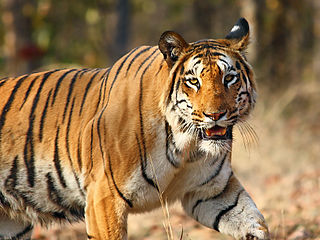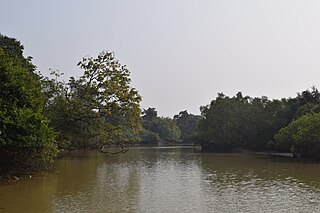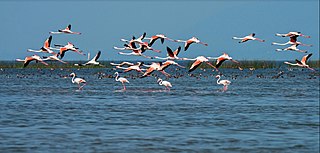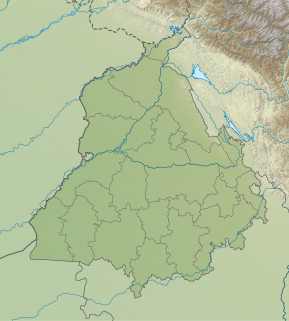 W
WThere are 41 Ramsar sites in India. These are wetlands deemed to be of "international importance" under the Ramsar Convention. For a full list of all Ramsar sites worldwide, see the List of Ramsar wetlands of international importance.
 W
WThe Asan Barrage or Assan Barrage is a barrage in the Uttarakhand-Himachal Pradesh border region in Doon Valley,, northern India, situated at the confluence of the Eastern Yamuna Canal and the Asan River and about 11 km (7 mi) from Dakpathar, and 28 km. northwest of Dehradun. The barrage is 287.5m long and has water throughout the year which is fed from the river Asan and the discharge channel of the river Yamuna. Since 2020 it has been declared as Uttarakhand's first Ramsar site.
 W
WAshtamudi Lake, in the Kollam District of the Indian state of Kerala, is the most visited backwater and lake in the state. It possesses a unique wetland ecosystem and a large palm-shaped water body, second only in size to the Vembanad estuary ecosystem of the state. Ashtamudi means 'eight braids' in the local Malayalam language. The name is indicative of the lake's topography with its multiple branches. The lake is also called the gateway to the backwaters of Kerala and is well known for its houseboat and backwater resorts. Ashtamudi Wetland was included in the list of wetlands of international importance, as defined by the Ramsar Convention for the conservation and sustainable utilization of wetlands.
 W
WBhitarkanika Mangroves is a mangrove wetland in Odisha, India, covering an area of 650 km (400 mi) in the Brahmani and Baitarani river deltas.
 W
WThe Bhoj Wetland consists of two lakes located in the city of Bhopal, the capital of the central Indian state of Madhya Pradesh. The two lakes are the Bhojtal & the Lower Lake, which lie to the west of the city center. The Bhojtal has an area of 31 km², and drains a catchment or watershed of 361 km². The watershed of the Bhojtal is mostly rural, with some urbanized areas around its eastern end. The lower lake has an area of 1.29 km². Its catchment is 9.6 km² and is mostly urbanized; the Lower Lake also receives subsurface seepage from the Bhojtal.
 W
WBhojtal, formerly known as Upper Lake, is a large lake which lies on the western side of the capital city of Madhya Pradesh, Bhopal, India. It is a major source of drinking water for the residents of the city, serving around 40% of the residents with nearly 30 million imperial gallons (140,000 m3) of water per day. Bada talaab, along with the nearby Chhota Talaab, meaning small lake in Hindi, constitute Bhoj Wetland, which is now a Ramsar site.
 W
WChilika Lake is a brackish water lagoon, spread over the Puri, Khurda and Ganjam districts of Odisha state on the east coast of India, at the mouth of the Daya River, flowing into the Bay of Bengal, covering an area of over 1,100 km. It is the largest coastal lagoon in India and the largest brackish water lagoon in the world after The New Caledonian barrier reef. It has been listed as a tentative UNESCO World Heritage site.
 W
WDipor Bil, also spelt Deepor Beel , is located to the south-west of Guwahati city, in Kamrup district of Assam, India It is a permanent freshwater lake, in a former channel of the Brahmaputra River, to the south of the main river. It is also called a wetland under the Ramsar Convention which has listed the lake in November 2002, as a Ramsar Site for undertaking conservation measures on the basis of its biological and environmental importance.
 W
WThe East Calcutta Wetlands,, are a complex of natural and human-made wetlands lying east of the city of Calcutta (Kolkata), of West Bengal in India. The wetlands cover 125 square kilometres and include salt marshes, as well as agricultural fields, sewage farms and settling ponds. The wetlands are also used to treat Kolkata's sewage, and the nutrients contained in the wastewater sustain fish farms and agriculture.
 W
WHarike Wetland also known as "Hari-ke-Pattan", with the Harike Lake in the deeper part of it, is the largest wetland in northern India in the border of Tarn Taran Sahib district and Ferozepur district of the Punjab state in India.
 W
WThe Hokersar is a wetland conservation area in Zainakote near Srinagar in the Indian union territory of Jammu and Kashmir. It lies in the Kashmir Valley, 10 kilometres (6.2 mi) northwest of Srinagar. The Hokersar, which spreads over 1,375 hectares (13.75 km2), is a designated bird sanctuary.
 W
WKanjli Wetland, a man made Wetland, which subsumes the Kanjli Lake, located in the Kapurthala district of Punjab state in India, was created in 1870 by constructing the headworks across the perennial Bien River, a tributary of the Beas River to provide irrigation facilities to the hinterland. The rich biodiversity of the wetland comprising aquatic, mesophytic and terrestrial flora and fauna including some important species of plants and animals was recognized internationally by the Ramsar Convention in 2002 by designating the Kanjli Lake in the List of Wetlands of International Importance. In this context, it is reported that the Punjab State which has 14 wetlands covering an area of 225.76 km2 has the unique position of three of its wetlands viz., the Kanjli Wetland covering an area of 490 ha of which the Kanjli Lake water spread is 184 ha), the Harike Wetland and the Ropar Wetland chosen by the Ministry of Environment and Forest (MoE&F), Government of India for their conservation and management are now also included in the Ramsar list covering a total area of 5650 ha; Kanjli is upstream of Harike wetland located in the Beas river basin while the Ropar wetland is in the Roopnagar district.
 W
WThe Kanwar Taal or Kabar Taal Lake located in Begusarai district of Bihar, India, is Asia's largest freshwater oxbow lake. It is approximately six times the size of the Bharatpur Sanctuary.
 W
WKeetham lake, also known as the Sur Sarovar, is a scenic lake just outside Agra on the Agra - Delhi highway. Alongside the Keetham Lake is the Agra Bear Rescue Facility, which is a Sloth bear rescue facility dedicated to rehabilitating previously enslaved 'dancing bears'. The lake has been designated as a protected Ramsar site since 2020.
 W
WKeoladeo National Park or Keoladeo Ghana National Park formerly known as the Bharatpur Bird Sanctuary in Bharatpur, Rajasthan, India is a famous avifauna sanctuary that hosts thousands of birds, especially during the winter season. Over 230 species of birds are known to be resident. It is also a major tourist centre with scores of ornithologists arriving here in the hibernal season. It was declared a protected sanctuary in 1971. It is also a World Heritage Site.
 W
WThe Kerala backwaters are a network of brackish lagoons and lakes lying parallel to the Arabian Sea coast of Kerala state in southern India, as well as interconnected canals, rivers, and inlets, a labyrinthine system formed by more than 900 kilometres (560 mi) of waterways, and sometimes compared to American bayous. The network includes five large lakes linked by canals, both man made and natural, fed by 38 rivers, and extending virtually half the length of Kerala state. The backwaters were formed by the action of waves and shore currents creating low barrier islands across the mouths of the many rivers flowing down from the Western Ghats range. In the midst of this landscape there are a number of towns and cities, which serve as the starting and end points of backwater cruises.
 W
WKolleru Lake is one of the largest freshwater lakes in India located in state of Andhra Pradesh and forms the largest shallow freshwater lake in Asia, 15 kilometers away from the Eluru and 65km from Rajamahendravaram. Kolleru is located between Krishna and Godavari deltas. Kolleru spans into two districts – Krishna and West Godavari. The lake is fed directly by water from the seasonal Budameru and Tammileru streams, and is connected to the Krishna and Godavari irrigation systems by over 67 major and minor irrigation canals. This lake is a major tourist attraction. Many birds migrate here in winter, such as Siberian crane, ibis, and painted storks. The lake was an important habitat for an estimated 20 million resident and migratory birds, including the grey or spot-billed pelican. The lake was declared as a wildlife sanctuary in November 1999 under India's Wildlife Protection Act of 1972, and designated a wetland of international importance in November 2002 under the international Ramsar Convention. The wildlife sanctuary covers an area of 308 km2.
 W
WLoktak Lake is the largest freshwater lake in North East India and is famous for the phumdis floating over it. The lake is located at Moirang in Manipur state, India. The etymology of Loktak is Lok = "stream" and tak = "the end". The largest of all the phumdis covers an area of 40 km2 (15 sq mi) and is situated on the southeastern shore of the lake. Located on this phumdi, Keibul Lamjao National Park is the only floating national park in the world. The park is the last natural refuge of the endangered Sangai, Rucervus eldii eldii or Manipur brown-antlered deer, one of three subspecies of Eld's deer.
 W
WLonar Lake, also known as Lonar crater, is a notified National Geo-heritage Monument, saline, soda lake, located at Lonar in Buldhana district, Maharashtra, India. Lonar Lake was created by an asteroid collision with earth impact during the Pleistocene Epoch. It is one of the four known, hyper-velocity, impact craters in basaltic rock anywhere on Earth. The other three basaltic impact structures are in southern Brazil. Lonar Lake has a mean diameter of 1.2 kilometres (3,900 ft) and is about 137 metres (449 ft) below the crater rim. The meteor crater rim is about 1.8 kilometres (5,900 ft) in diameter.
 W
WMaharana Pratap Sagar, in India, also known as Pong Reservoir or Pong Dam Lake was created in 1975, by building the highest earthfill dam in India on the Beas River in the wetland zone of the Siwalik Hills of the Kangra district of the state of Himachal Pradesh. Named in the honour of Maharana Pratap (1540–1597), the reservoir or the lake is a well-known wildlife sanctuary and one of the 27 international wetland sites declared in India by the Ramsar Convention. The reservoir covers an area of 24,529 hectares, and the wetlands portion is 15,662 hectares.
 W
WMansar Lake is situated 37 km (23 mi) from Jammu, Mansar is a lake fringed by forest-covered hills, over a mile in length by half-a-mile in width. Surinsar-Mansar Lakes are designated as Ramsar Convention in November 2005.
 W
WNal Sarovar Bird Sanctuary, consisting primarily of a 120.82-square-kilometre (46.65 sq mi) lake and ambient marshes, is situated about 64 km to the west of Ahmedabad near Sanand Village, in the Gujarat state of India. Mainly inhabited by migratory birds in winter and spring, it is the largest wetland bird sanctuary in Gujarat, and one of the largest in India. It was declared a bird sanctuary in April 1969.
 W
WNalbana Bird Sanctuary or Nalbana Island is the core area of the Ramsar designated wetlands of Chilika Lake. It was declared a bird sanctuary under the Wildlife Protection Act in 1972. In the heart of the park, one can see thousands of birds descending during the migratory season. The island disappears during monsoon season due to inundation only to emerge again in post-monsoon.
 W
WNawabganj Bird Sanctuary, renamed in 2015 Shahid Chandra Shekhar Azad Bird Sanctuary, is a bird sanctuary located in Unnao district on the Kanpur-Lucknow highway in Uttar Pradesh, India consisting of a lake and the surrounding environment. It is one of the many wetlands of Northern India. The sanctuary provides protection for 250 species of migratory birds mostly from CIS countries, but the numbers have been dwindling since the 1990s, most having relocated to newer areas in Himachal and Rajasthan. The sanctuary also houses a deer park, watchtowers and boats.
 W
WKodiakkarai also called Point Calimere or Cape Calimere,, is a low headland on the Coromandel Coast, in the Nagapattinam district of the state of Tamil Nadu, India. It is the apex of the Cauvery River delta, and marks a nearly right-angle turn in the coastline. The region is located about 9 kilometres southerly to Vedaranyam. The antiquity of the region is evident by the extant Kodi Kuzhagar temple of Chola pediod. Also, a historic landmark here was the Chola lighthouse, destroyed in the tsunami of 2004.
 W
WPoint Calimere Wildlife and Bird Sanctuary (PCWBS) is a 21.47-square-kilometre (8.29 sq mi) protected area in Tamil Nadu, South India along the Palk Strait where it meets the Bay of Bengal at Point Calimere at the southeastern tip of Nagapattinam District. The sanctuary was created in 1967 for conservation of the least concern blackbuck antelope, an endemic mammal species of India. It is famous for large congregations of waterbirds, especially greater flamingos. International name: Point Calimere Wildlife Sanctuary, IBA Code: IN275, Criteria: A1, A4i, A4iii. The 7-square-kilometre (2.7 sq mi) core area of this sanctuary has been proposed as a National Park
 W
WRenuka lake is in the Sirmaur district of Himachal Pradesh in India and it is 672 m above the sea level. It is the largest lake in Himachal Pradesh, with a circumference of about 3214 m. This lake was named after the goddess Renuka. It is well connected by the road. Boating is available on the lake. A lion safari and a zoo are there at Renuka. It is the site of an annual fair held in November. It is designated as Ramsar site since November 2005. Renuka was the mother of Parshuram.
 W
WRopar Wetland, also named Ropar Lake, is a man-made freshwater riverine and lacustrine wetland. The area has at least 9 mammal, 154 bird, 35 fish, 9 arthropod, 11 rotifer, 9 crustacean and 10 protozoan species, making it biologically diverse. This important ecological zone is located in the Shivalik foothills of the Lower Himalayas and was created in 1952 on the Sutlej River, in the Punjab state of India, by building a head regulator to store and divert water for beneficial uses of irrigation, drinking and industrial water supply. The endangered turtle Chitra indica and the threatened snake Python molurus, as per IUCN Red List, are reported to be resident in the wetland. Considering the wetland's diverse and rich biodiversity, Ramsar Convention has included Ropar Wetland as one of the Ramsar sites among the 27 sites listed under India, for "the conservation of global biological diversity and for sustaining human life through the ecological and hydrological functions they perform."
 W
WRudrasagar Lake, also known as Twijilikma, is a lake located in Melaghar, Tripura, India.
 W
W}}
 W
WSandi Bird Sanctuary is a bird sanctuary in Hardoi district of Uttar Pradesh, India.
 W
WSarsai Nawar Wetland, also known as Sarsai Nawar Jheel is a bird sanctuary in Sarsai Nawar, Etawah district, Uttar Pradesh, India. It aims to conserve waterbirds, notably the Sarus Crane. It has been designated as a protected Ramsar site since 2019.
 W
WSasthamcotta Lake or Sasthamkotta Lake, also categorized as a wetland, is the largest fresh water lake in Kerala, a state of India on the south of the West Coast. The lake is named after the ancient Sastha temple located on its bank. It meets the drinking water needs of half million people of the Quilon district and also provides fishing resources. The purity of the lake water for drinking use is attributed to the presence of large population of larva called cavaborus that consumes bacteria in the lake water. The lake is a designated wetland of international importance under the Ramsar Convention since November 2002.
 W
WThe Sundarbans is a mangrove area in the delta formed by the confluence of the Ganges, Brahmaputra and Meghna Rivers in the Bay of Bengal. It spans from the Hooghly River in India's state of West Bengal to the Baleswar River in Bangladesh. It comprises closed and open mangrove forests, agriculturally used land, mudflats and barren land, and is intersected by multiple tidal streams and channels. Four protected areas in the Sundarbans are enlisted as UNESCO World Heritage Sites, viz. Sundarbans National Park, Sundarbans West, Sundarbans South and Sundarbans East Wildlife Sanctuaries. Despite these protections, the Indian Sundarbans were considered endangered in a 2020 assessment under the IUCN Red List of Ecosystems framework.
 W
WThe Sundarbans National Park is a national park, tiger reserve, and biosphere reserve in West Bengal, India. It is part of the Sundarbans on the Ganges Delta, and adjacent to the Sundarban Reserve Forest in Bangladesh. The delta is densely covered by mangrove forests, and is one of the largest reserves for the Bengal tiger. It is also home to a variety of bird, reptile and invertebrate species, including the salt-water crocodile. The present Sundarban National Park was declared as the core area of Sundarban Tiger Reserve in 1973 and a wildlife sanctuary in 1977. On 4 May 1984 it was declared a national park. It is a UNESCO World Heritage Site inscribed in 1987, and it has been designated as a Ramsar site since 2019. It is considered as a World Network of Biosphere Reserve from 1989.
 W
WThrissur Kole Wetlands is a wetland lying in Thrissur District in Kerala, India. It gives 40 per cent of the Kerala’s rice requirement and acts as a natural drainage system for Thrissur city and Thrissur District. The Kole Wetlands is one of largest, highly productive and threatened wetlands in Kerala and it comes in Central Asian Flyway of migratory birds. [[File:Journey of bhagavathi.jpg|thumb|right|Kole Wetlands in [[Puzhakkal,Enamavu], Thrissur City]]
 W
WTso Moriri or Lake Moriri or "Mountain Lake", is a lake in the Changthang Plateau in Ladakh in Northern India. The lake and surrounding area are protected as the Tso Moriri Wetland Conservation Reserve.
 W
WVembanad is the longest lake in India,and the largest lake in the state of Kerala[Mangrove with area 2114 sq. Km is the second largest Ramasar site in India only after Sunderbans in West Bengal] Spanning several districts in the state of Kerala, it is known as Vembanadu Lake in Kottayam, Punnamada Lake in Alappuzha and Kochi Lake in Kochi. Several groups of small islands including Vypin, Mulavukad, Vallarpadam, Willingdon Island are located in the Kochi Lake portion. Kochi Port is built around the Willingdon Island and the Vallarpadam island.
 W
WWular Lake is one of the largest fresh water lakes in Asia. It is sited in Bandipora district in Jammu and Kashmir, India. The lake basin was formed as a result of tectonic activity and is fed by the Jhelum River. The lake's size varies seasonally from 12 to 100 square miles. In addition, much of the lake has been drained as a result of willow plantations being built on the shore in the 1950s.